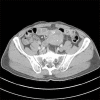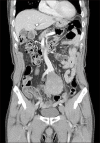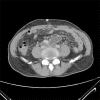Huge Pseudoaneurysm at the Aortic Bifurcation Misdiagnosed as a Mesenchymal Tumor: A Case Report
- PMID: 38303149
- PMCID: PMC10835026
- DOI: 10.5758/vsi.230096
Huge Pseudoaneurysm at the Aortic Bifurcation Misdiagnosed as a Mesenchymal Tumor: A Case Report
Abstract
Aortic pseudoaneurysms (PA) vary in size and may remain asymptomatic. PAs may be caused by vascular injury, such as trauma or surgery, or other non-traumatic causes, such as Bechet disease, infection, or penetrating atherosclerotic ulcers. The diagnosis of PAs may have been delayed for decades. We present a case of a PA detected incidentally in a male patient who experienced traumatic bowel perforation due to blunt abdominal trauma 30 years before presentation. Computed tomography (CT) displayed a 9.2 cm mass in the pelvis, initially considered a neoplasm of small bowel origin. Further analysis of the CT images suggested a thrombosed PA at the aortic bifurcation, which was confirmed via surgical exploration. Graft interposition was performed using a Dacron 16-8 mm graft and the patient recovered without any complications. This case highlights the importance of a high index of suspicion for the diagnosis of a thrombosed aortic PA.
Keywords: Abdominal aorta; False aneurysm; Penetrating atherosclerotic ulcer; Vascular system injuries.
Conflict of interest statement
Seung-Kee Min have been the editorial board member of the VSI since 2019. He was not involved in the review process. Otherwise, no potential conflict of interest relevant to this article was reported.
Figures





References
-
- Jang HY, Choi JH, Nam YJ, Jeon MS, Lee HW, Lee HC. Endovascular treatment of an abdominal aortic pseudoaneurysm in a patient with Behçet's disease. Korean J Med. 2014;86:494–499. doi: 10.3904/kjm.2014.86.4.494. https://doi.org/10.3904/kjm.2014.86.4.494. - DOI
-
- Shalhub S, Starnes BW, Tran NT, Hatsukami TS, Lundgren RS, Davis CW, et al. Blunt abdominal aortic injury. J Vasc Surg. 2012;55:1277–1285. doi: 10.1016/j.jvs.2011.10.132. https://doi.org/10.1016/j.jvs.2011.10.132. - DOI - PubMed
-
- Lassonde J, Laurendeau F. Blunt injury of the abdominal aorta. Ann Surg. 1981;194:745–748. doi: 10.1097/00000658-198112000-00014. https://doi.org/10.1097/00000658-198112000-00014. - DOI - PMC - PubMed
-
- Lock JS, Huffman AD, Johnson RC. Blunt trauma to the abdominal aorta. J Trauma. 1987;27:674–677. doi: 10.1097/00005373-198706000-00015. https://doi.org/10.1097/00005373-198706000-00015. - DOI - PubMed
Publication types
LinkOut - more resources
Full Text Sources

